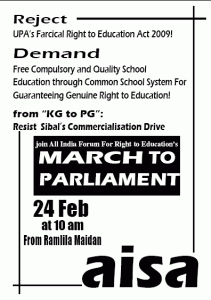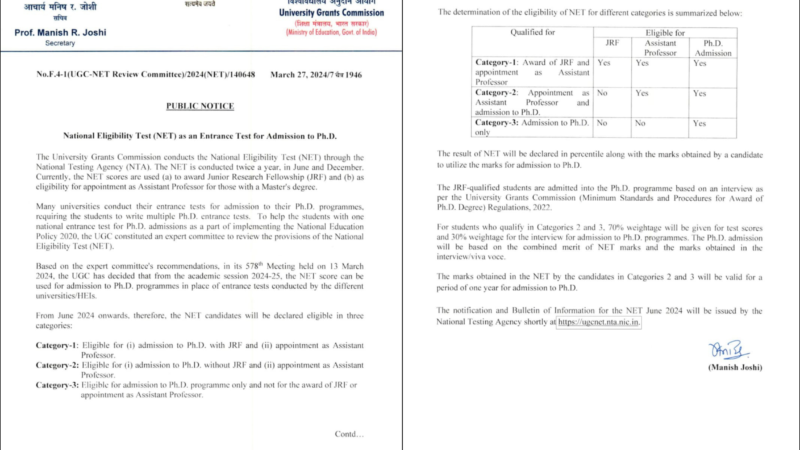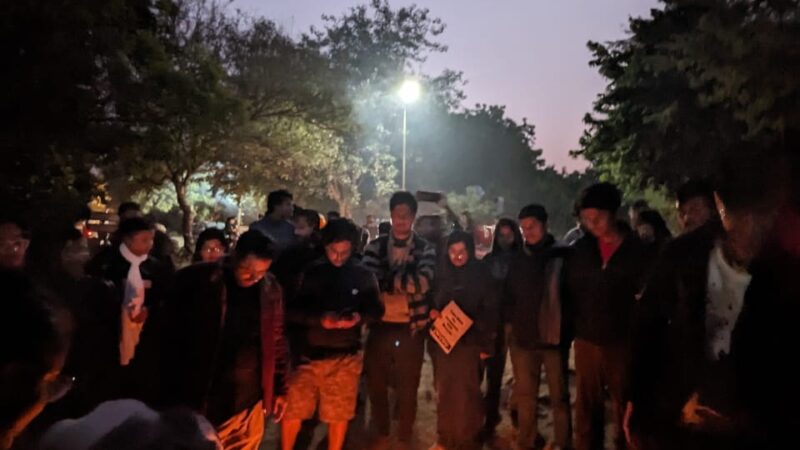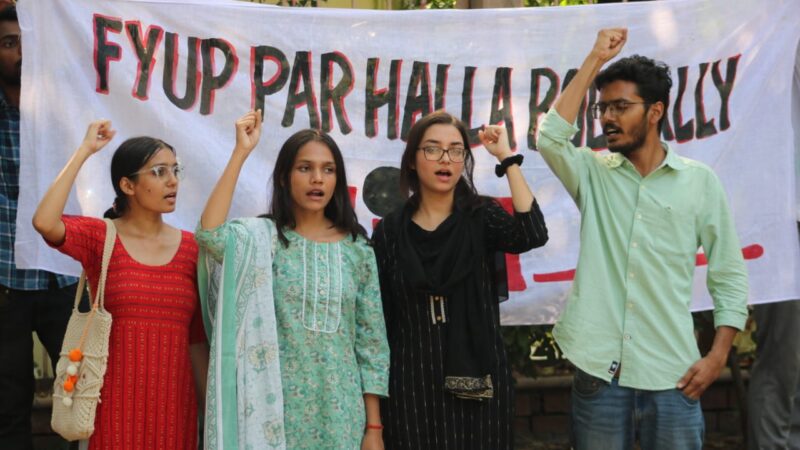From “KG to PG”: Resist Sibal’s Commercialisation Drive: Join All India Forum For Right to Education’s March to Parliament
Reject UPA’s Farcical Right to Education Act 2009!
Demand Free Compulsory and Quality School
Education through Common School System For
Guaranteeing Genuine Right to Education!
from “KG to PG”: Resist Sibal’s Commercialisation Drive
join All India Forum For Right to Education’s
MARCH to Parliament
24 Feb at 10 am
From Ramlila Maidan to Parliament Street
The Arjun Sengupta Committee on the Unorganized Sector reported that 93% of India’s working population is employed in the unorganized sector, and 2/3rds of these families subsist on 20 rupees a day.
 For these groups, the right to education and employment would enable them to escape the unorganized sector and earn more than bare subsistence.
For these groups, the right to education and employment would enable them to escape the unorganized sector and earn more than bare subsistence.
Does the recently introduced Right to Education Bill, passed unanimously in Parliament in 2009, fulfill any of these expectations? The answer to this question is an emphatic ‘NO’.
How should ‘Right to Education’ be defined?
In 1993, in its landmark Unnikrishnan judgment, the Supreme Court declared that from birth until the age of 14, children were entitled to free and compulsory education and this was accorded the status of a basic right. Children below the age of 6 were to be given adequate nutrition, healthcare, a safe childhood, and pre-primary education (KG, nursery). Children between the ages of 6 and 14 were granted the basic right to primary education for these eight years. This is the most widely accepted definition of the ‘Right to Education’: namely – the right of all children until the age of 14 to nutrition, healthcare, safety, and education of an equitable standard free of cost.
But in 2002, the BJP-led NDA Government under the 86th Constitutional Amendment Act (2002) inserted a new Article (21A) in the Constitution, making the Unnikrishnan judgement redundant by defining according to the whims of the government what constitutes ‘free and compulsory education’.
The UPA’s ‘Right to Education’ Bill in its present form is based on the 86th Amendment. It is, therefore, nothing but the next step in curbing the Unnikrishnan judgement’s mandate of genuine right to education as a constitutionally mandated “fundamental rights”.
The problems with the RTE in its present form
The RTE is its present form has several fundamental, structural problems and ambiguities that shelve it of ANY potential to really provide universal right to education.
- In the name of free, compulsory and universal education, all that the RTE promises is that 25% seats in private schools will be reserved for poor students for “free” education in private schools. The government claims that it will pick up the tab for the tuition fees for these children. However, the fact is that the government only promises to provide “vouchers” to poor children equivalent to the admission fees of government schools. The question remains as to how these children from poor families pay ‘picnic’ fees, textbook ‘fees’, sports ‘fees’ and other such expenses that private schools regularly extort?
- There are today 19 crore children in the age bracket between 6-14 years . Of these, 4 crore children study in established private schools. If, with 25% reservation, 1 crore children get access to education, then what will happen to the remaining 18 crores? Also, once these private schools realize that the government is willing to reimburse their fees, will not their instinct be to raise these fees even higher so that they can make even greater profits?
- Even if poor students manage to survive until Class 8, what will happen after this, when the government stops paying their fees? These children will be out on the streets once more, while those of their classmates who could pay the exorbitant fees, will pass Class 12 and go on to enter the hallowed portals of IITs, IIMs or prestigious foreign universities.
- For all practical purposes, through the RTE, the government is facilitating the handing over of government schools to private ownership through public-private partnerships. Instead of doing this, shouldn’t the state be working to set up better government schools?
- This is not the first time that the “free” schooling has been promised – residents of Delhi are well aware that private schools in the city were provided land practically free of cost by the government, in return for which supposed to give “free” education to poor children. Exactly how many poor children are able to access these elite facilities is there for anyone to see.
- What is even more absurd is that this Bill states that if any citizen wishes to go to court against any private school, then he or she must first take permission from the requisite government authority! Clearly, the state desires to lend itself to supporting and protecting the interests of the already powerful private schools rather than actually bringing in legislation to expand the domain of education.
The RTE in its present form is a farce in the name of genuine right to education – it designed to keep in place the discriminatory, multi-layered education system that currently prevails. The Right to education bill cannot be seen in isolation from the other moves of the UPA Government to institute a wholesale commercialization and privatization of education. In the field of higher education, whether it is through the Yashpal Committee Recommendations or the Knowledge Commission Report, all-out moves are being made to turn education into a commodity which will be out of the reach of the many, but will be a privilege available to the very few.
The Right to Education Bill proclaims that it is providing education as a ‘right’ where it is in fact taking this right away. It needs to be seen as yet another nail in the coffin of providing universal, affordable and quality education: instead, it paves the way for handing over whatever existing government schools to private players.
There is one answer to these complexities — a Common Schooling System where every school [including the private schools] will be a neighborhood school. A full public-funded common education system alone can guarantee free education of equitable quality from pre-primary to higher education. The Right to Education in a true form will not be available so long as the present neo-liberal policy of making education a commodity for profit continues unchecked.
AISA, in association with the All India Forum for Right to Education is organizing a Parliament Rally on 24 February 2010 to uphold a Genuine Right to Education based on Common Schooling and Neighborhood schools in place of the UPA’s farcical RTE Act. The March will start at 10 am from Ramlila Ground and culminate in a Rally at Parliament Street. We appeal to you to join this March to ensure the status of education as a basic right.


